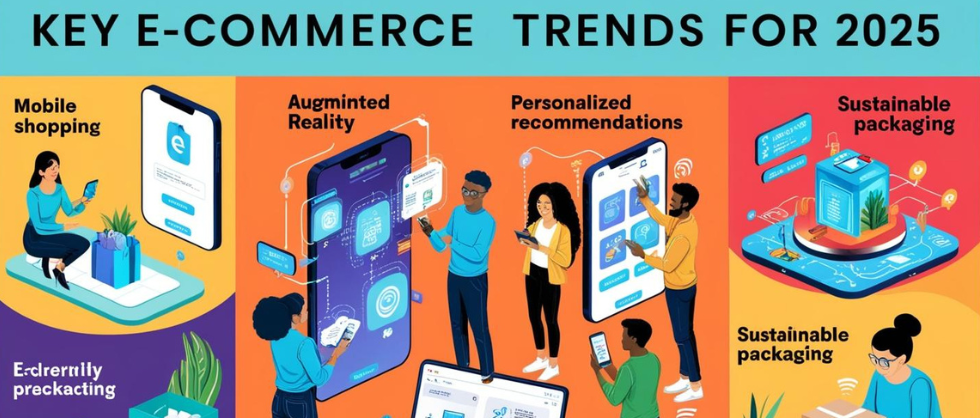E-commerce continues to evolve at a rapid pace, and businesses that want to stay competitive need to stay ahead of the curve. As we head into 2025, several emerging e-commerce trends are shaping the future of online retail. From AI-driven personalization to sustainable shopping, understanding these trends can help you make informed decisions, optimize your online store, and meet changing customer expectations.
In this blog, we’ll explore the top e-commerce trends that will dominate in 2025 and beyond. Whether you’re a seasoned entrepreneur or a startup looking to thrive in the digital marketplace, these trends will help you remain relevant and successful.
1. AI and Machine Learning for Personalization
Personalization has been a buzzword in e-commerce for several years, but in 2025, it will become even more refined and AI-driven. Artificial intelligence (AI) and machine learning technologies are revolutionizing how businesses interact with customers. By using AI, e-commerce businesses can analyze customer data in real-time and deliver highly personalized shopping experiences.
AI can recommend products based on browsing history, purchase patterns, and preferences. It can also help in dynamic pricing, adjusting prices based on demand, competition, and consumer behavior. Additionally, AI-powered chatbots are expected to become more sophisticated, providing 24/7 customer support, solving issues instantly, and enhancing the overall user experience.
Key Benefit: AI-driven personalization allows brands to offer a tailor-made experience that increases customer satisfaction, boosts sales, and fosters loyalty.
2. Voice Search and Voice Commerce
With the increasing popularity of voice assistants like Amazon Alexa, Google Assistant, and Apple Siri, voice search is set to play a major role in e-commerce in 2025. Voice commerce, or “v-commerce,” is revolutionizing how customers interact with online stores. More and more consumers are using voice commands to search for products, make purchases, and even reorder items.
For e-commerce businesses, optimizing your site for voice search is crucial. This means focusing on natural language processing (NLP) and ensuring your content is conversational and easily discoverable through voice queries. The rise of voice commerce also means businesses should streamline the checkout process to accommodate voice-driven purchases seamlessly.
Key Benefit: Voice search offers a hands-free, convenient shopping experience that appeals to busy consumers, making it an essential feature for e-commerce success.
3. Social Commerce and Shoppable Posts
Social commerce is booming, and 2025 will see even more integration of shopping features within social media platforms. Platforms like Instagram, TikTok, and Facebook already allow businesses to showcase products and sell directly through their sites. This trend is expected to grow exponentially as social media becomes a primary shopping destination for consumers.
Shoppable posts are likely to evolve with more interactive features, such as live shopping events and virtual try-ons. Social media platforms are continuously improving their e-commerce features, and integrating these capabilities into your digital marketing strategy will allow you to tap into the vast audience that uses these platforms to discover and buy products.
Key Benefit: Social commerce allows businesses to meet customers where they already spend their time, driving engagement and increasing sales through seamless integration with social media.
4. Sustainability and Eco-Friendly Shopping
Sustainability is no longer just a trend—it’s a necessity. As more consumers become aware of the environmental impact of their purchasing decisions, e-commerce businesses are feeling the pressure to adopt sustainable practices. From eco-friendly packaging to carbon-neutral shipping, sustainability will be a major focus in the e-commerce landscape by 2025.
Eco-conscious consumers are actively seeking brands that align with their values, prioritizing sustainability in everything from product materials to business operations. Brands that adopt environmentally friendly practices and communicate their sustainability efforts will stand out and gain customer loyalty in a competitive market.
Key Benefit: Adopting sustainable practices not only helps the planet but also appeals to the growing number of eco-conscious consumers, enhancing brand reputation and customer trust.
5. Augmented Reality (AR) Shopping Experiences
Augmented reality (AR) is poised to revolutionize the way customers shop online, particularly in industries like fashion, beauty, and home decor. By 2025, AR shopping will be more accessible and advanced, allowing consumers to try before they buy—virtually.
For example, AR can enable virtual try-ons for clothing, allowing customers to see how a product looks on them without physically trying it on. In the furniture and home decor sector, AR allows customers to visualize how products will look in their homes before making a purchase. This immersive shopping experience boosts customer confidence, reduces return rates, and enhances customer satisfaction.
Key Benefit: AR bridges the gap between online and offline shopping experiences, giving customers the ability to visualize products in real-time, which can lead to higher conversion rates.
6. Subscription-Based E-Commerce Models
Subscription-based e-commerce is one of the fastest-growing models, with businesses across industries—from beauty to food delivery—embracing this approach. By 2025, subscription boxes and recurring services are expected to become even more popular, offering businesses a consistent and predictable revenue stream.
This model works particularly well for businesses that sell consumable goods, curated product bundles, or services. Subscription businesses are also tapping into the convenience factor, offering customers the ease of automatic reordering and personalized product selections.
Key Benefit: Subscription models create predictable revenue streams, foster customer loyalty, and provide a steady demand for products, making them an ideal business model for long-term growth.
7. Frictionless Payment Solutions
Consumers expect seamless, hassle-free checkout experiences. In 2025, businesses will need to integrate frictionless payment solutions into their e-commerce platforms. Digital wallets, one-click payments, and mobile payment options like Apple Pay, Google Pay, and PayPal are becoming the norm.
The rise of contactless payment options in physical stores is also influencing online payment systems. The quicker and easier it is to make a purchase, the better the chances of converting a potential customer into a sale. Reducing friction in the checkout process is key to improving conversion rates and reducing cart abandonment.
Key Benefit: Streamlined payment processes enhance the customer experience and increase conversion rates by removing barriers to completing a purchase.
8. Same-Day and Autonomous Delivery
Fast delivery is no longer just a luxury; it’s becoming an expectation. In 2025, e-commerce companies will need to adopt same-day delivery or next-day delivery options to compete with giants like Amazon. Additionally, autonomous delivery technologies—such as drones and robots—are expected to become more common, providing faster, more efficient delivery methods.
Consumers are increasingly looking for instant gratification when it comes to online shopping, and offering ultra-fast, reliable delivery will give your business a competitive edge.
Key Benefit: Faster delivery options enhance customer satisfaction and create a seamless shopping experience that meets consumer expectations for convenience.
As we approach 2025, staying on top of the latest e-commerce trends is essential for maintaining a competitive edge. From AI-powered personalization to voice search and sustainable shopping, the future of e-commerce will be defined by technological innovation, customer-centric strategies, and a focus on sustainability.
By embracing these trends, businesses can create better shopping experiences, improve customer satisfaction, and drive sales growth in the fast-evolving digital marketplace.
Make sure to integrate these e-commerce trends into your business strategy, and stay ahead of the curve as you continue to grow your online store in 2025 and beyond.




